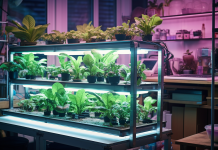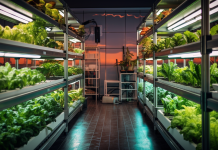Discover the art of troubleshooting hydroponic challenges, where every obstacle becomes an opportunity for growth.
In this article, we delve into the world of pests, nutrient imbalances, and the delicate balance of acidity and alkalinity in hydroponics.
With a focus on identifying common pests, preventing nutrient imbalances, and maintaining optimal oxygen levels, we offer effective solutions for overcoming these hurdles.
Identifying and Managing Common Hydroponic Pests
One of the key aspects of troubleshooting hydroponic challenges is the identification and management of common hydroponic pests. Preventing pest infestation is crucial in maintaining the health and productivity of your hydroponic system.
Fortunately, there are organic pest control methods that can help in keeping these intruders at bay. One effective method is the use of beneficial insects, such as ladybugs or lacewings, which feed on harmful pests like aphids or spider mites.
Additionally, implementing physical barriers like netting or screens can prevent pests from entering your hydroponic setup. Regular monitoring and inspection of plants can also aid in early pest detection and prompt action.
By employing these organic pest control methods, you can ensure a pest-free hydroponic garden, promoting optimal growth and yield.
Preventing Nutrient Imbalances in Your Hydroponic System
To ensure optimal plant growth and health in your hydroponic system, it is essential to employ strategies that prevent nutrient imbalances from occurring within the nutrient solution. Preventing nutrient deficiencies and optimizing nutrient ratios are key steps in maintaining a well-balanced hydroponic system. By monitoring and adjusting the nutrient levels regularly, you can prevent deficiencies or excesses of essential elements. Additionally, ensuring a proper pH level and using high-quality nutrient solutions can help maintain a balanced nutrient profile. Here is a visual representation of strategies to prevent nutrient imbalances in your hydroponic system:
| Strategies | Benefits |
| Regular monitoring | Identifies nutrient imbalances early |
| Adjusting nutrient levels | Prevents deficiencies or excesses |
| Maintaining pH levels | Ensures optimal nutrient uptake |
| Using high-quality nutrients | Provides a balanced nutrient profile |
The Role of Ph in Hydroponics: Balancing Acidity and Alkalinity
Maintaining the proper pH level is crucial in hydroponics as it ensures the optimal balance between acidity and alkalinity for the successful growth of plants. Balancing pH levels is important because fluctuations can lead to nutrient deficiencies, stunted growth, and even plant death.
To ensure the pH level remains within the desired range, regular testing is necessary. Several pH testing methods are available for hydroponic systems, including pH test strips, pH meters, and liquid pH testing kits. pH test strips are quick and easy to use, providing a general indication of the pH level. pH meters offer more precise readings and are suitable for more experienced growers. Liquid pH testing kits are another option and provide accurate results when used correctly.
Troubleshooting Hydroponic Diseases: Causes and Solutions
Hydroponic diseases can be caused by various factors, but with proper identification and effective solutions, growers can successfully overcome these challenges. Disease prevention is crucial in hydroponics to ensure healthy plant growth and maximize yields. To troubleshoot hydroponic diseases, growers can employ the following techniques:
– Maintain proper hygiene: Regularly clean and sanitize the hydroponic system to prevent the buildup of pathogens.
– Monitor nutrient levels: Imbalances in nutrient solutions can weaken plants and make them more susceptible to diseases. Regularly test and adjust nutrient levels to maintain optimal plant health.
– Implement integrated pest management (IPM): Pests can introduce diseases to hydroponic systems. Use IPM strategies to prevent and manage pest infestations.
– Provide adequate ventilation: Proper airflow helps prevent the buildup of humidity and reduces the risk of fungal diseases.
– Practice crop rotation: Avoid planting the same crops in the same location to minimize the risk of disease transmission and buildup.
Maximizing Nutrient Uptake: Understanding Plant Nutrition in Hydroponics
During the growth cycle of hydroponic plants, it is essential to ensure optimal nutrient uptake by understanding the principles of plant nutrition in hydroponics. Improving nutrient absorption is crucial for the overall health and productivity of the plants. One way to achieve this is by optimizing hydroponic fertilizers. These fertilizers are specifically formulated to provide the necessary macro and micronutrients in a readily available form for plants. Understanding micronutrient deficiencies is also crucial in diagnosing and correcting nutrient imbalances. Micronutrients such as iron, zinc, and manganese play vital roles in plant metabolism and growth. By closely monitoring the nutrient levels in the hydroponic system and addressing any deficiencies promptly, growers can maximize nutrient uptake and ensure healthy plant growth.
| Macro Nutrients | Function |
| Nitrogen | Promotes leaf and stem growth |
| Phosphorus | Enhances root development and flower formation |
| Potassium | Improves overall plant vigor and disease resistance |
| Micronutrients | Function |
| Iron | Essential for chlorophyll synthesis |
| Zinc | Aids in enzyme activation and hormone production |
| Manganese | Assists in photosynthesis and nitrogen metabolism |
Maintaining Optimal Oxygen Levels in Your Hydroponic Reservoir
To ensure proper aeration, growers must prioritize the consistent circulation of oxygen in their hydroponic reservoir. Maintaining proper aeration is crucial for the overall health and success of the plants. Adequate oxygen levels in the reservoir promote healthy root growth and prevent root rot, a common problem in hydroponic systems.
Here are some tips to maintain optimal oxygen levels in your hydroponic reservoir:
– Use an air pump and air stones: These devices help to oxygenate the water by creating bubbles and increasing the surface area for oxygen exchange.
– Monitor water temperature: Warmer water holds less dissolved oxygen. Keep the water temperature within the recommended range for your specific crop.
– Avoid overstocking the reservoir: Overcrowding can lead to reduced oxygen availability. Maintain a proper plant-to-water ratio.
– Regularly clean and replace air stones: Over time, air stones can become clogged with mineral deposits, reducing their effectiveness. Clean and replace them as needed.
– Consider adding hydrogen peroxide: In small amounts, hydrogen peroxide can help increase oxygen levels in the water.
Troubleshooting Temperature Fluctuations in Hydroponic Systems
Temperature control is a critical aspect of maintaining optimal conditions in hydroponic systems. Fluctuations in temperature can have a significant impact on plant growth and overall system performance. To troubleshoot temperature issues, it is important to address any lighting issues and optimize water circulation.
| Potential Issue | Possible Solution |
| Lighting issues | Ensure proper placement |
| Use appropriate wattage | |
| Consider supplemental lighting | |
| Regularly clean and maintain lights | |
| Water circulation | Check pump functionality |
| Adjust flow rate | |
| Use air stones or diffusers for aeration | |
| Monitor and adjust water temperature |
Effective Solutions for Algae Control in Hydroponics
One effective solution for controlling algae in hydroponics is the use of natural additives. These additives can help to prevent the growth of algae and maintain a healthy hydroponic system.
Here are some algae prevention techniques and control methods that can be implemented in hydroponics:
– Use beneficial bacteria: Beneficial bacteria can help to outcompete algae for nutrients, preventing its growth.
– Implement light control: Controlling the amount and duration of light exposure can limit algae growth.
– Maintain proper nutrient balance: Ensuring that the nutrient solution is properly balanced can prevent excess nutrients that can fuel algae growth.
– Maintain proper pH levels: Monitoring and adjusting pH levels can deter algae growth.
– Regular cleaning and maintenance: Regularly cleaning and maintaining the hydroponic system can help to prevent algae buildup.
Frequently Asked Questions
How Do I Set up a Hydroponic System?
To set up a hydroponic system, you will need equipment such as a reservoir, grow trays, grow lights, and a nutrient solution. Follow step-by-step instructions to assemble and connect the components for optimal plant growth. Regular maintenance includes troubleshooting common issues and managing the nutrient solution.
What Are the Benefits of Using Hydroponics?
Vertical farming using hydroponics offers numerous advantages for urban agriculture. These include higher crop yield, efficient use of water and space, reduced reliance on pesticides, and the ability to grow fresh produce year-round in controlled environments.
Can I Use Regular Soil in a Hydroponic System?
Using regular soil in a hydroponic system is not recommended as it can lead to clogging and nutrient imbalances. However, soil substitutes such as coco coir or rockwool can be used effectively to support plant growth in hydroponics.
How Often Should I Check the Ph Levels in My Hydroponic System?
Regular monitoring of pH levels is essential for maintaining a healthy hydroponic system. While some may find it tedious, checking pH levels at least once a week can prevent nutrient imbalances and ensure optimal plant growth.
What Types of Plants Can Be Grown Using Hydroponics?
Hydroponics offers a versatile method for growing plants both indoors and outdoors. Compared to soil-based plant growth, hydroponics allows for more precise control over nutrient levels and eliminates the risk of soil-borne pests.
Key Takeaways
– Implementing integrated pest management strategies is crucial for controlling pests in hydroponics, including the use of beneficial insects, physical barriers, and regular monitoring.
– Regularly monitoring nutrient levels and adjusting them accordingly is essential for preventing nutrient imbalances and promoting optimal plant growth and health.
– Maintaining proper hygiene, adjusting nutrient levels, and implementing integrated pest management strategies are important for preventing and managing diseases in hydroponics.
– Maximizing nutrient uptake requires optimizing hydroponic fertilizers, closely monitoring nutrient levels, and understanding the importance of macro and micronutrients in plant development and disease resistance.
Conclusion
In conclusion, troubleshooting hydroponic challenges requires careful attention to:
– Pests
– Nutrient imbalances
– pH levels
– Diseases
– Plant nutrition
– Oxygen levels
– Temperature fluctuations
– Algae control
By identifying and addressing these issues, hydroponic growers can maximize the health and productivity of their plants.
With dedication and knowledge, hydroponic gardening can be a rewarding and efficient method of cultivation, leading to:
– Bountiful harvests
– A sense of accomplishment like no other.
Please see our supporting article:
The Essential Role of Microbes in Hydroponics



